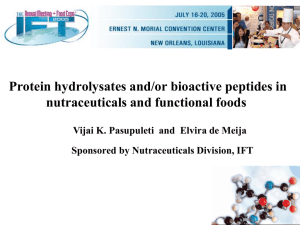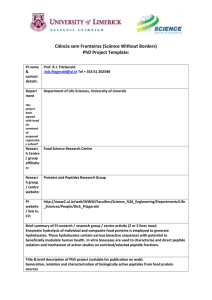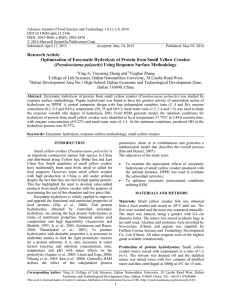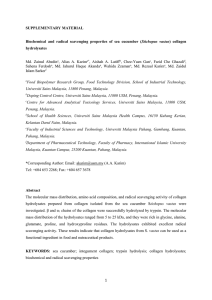Advance Journal of Food Science and Technology 5(6): 752-757, 2013
advertisement
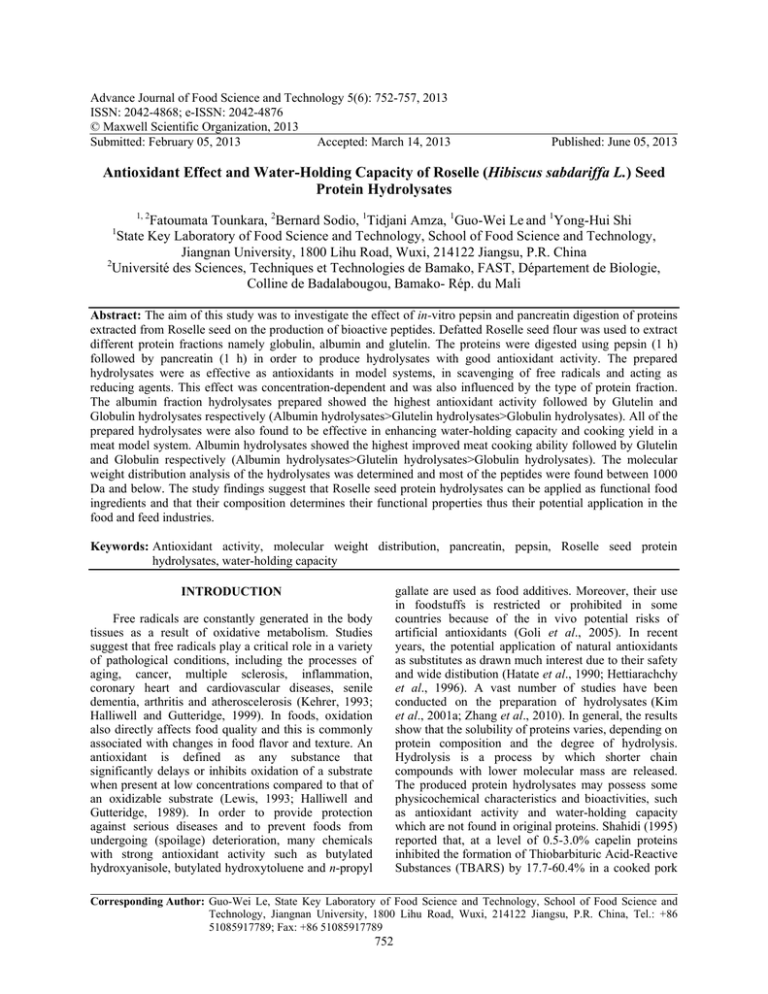
Advance Journal of Food Science and Technology 5(6): 752-757, 2013 ISSN: 2042-4868; e-ISSN: 2042-4876 © Maxwell Scientific Organization, 2013 Submitted: February 05, 2013 Accepted: March 14, 2013 Published: June 05, 2013 Antioxidant Effect and Water-Holding Capacity of Roselle (Hibiscus sabdariffa L.) Seed Protein Hydrolysates 1, 2 Fatoumata Tounkara, 2Bernard Sodio, 1Tidjani Amza, 1Guo-Wei Le and 1Yong-Hui Shi State Key Laboratory of Food Science and Technology, School of Food Science and Technology, Jiangnan University, 1800 Lihu Road, Wuxi, 214122 Jiangsu, P.R. China 2 Université des Sciences, Techniques et Technologies de Bamako, FAST, Département de Biologie, Colline de Badalabougou, Bamako- Rép. du Mali 1 Abstract: The aim of this study was to investigate the effect of in-vitro pepsin and pancreatin digestion of proteins extracted from Roselle seed on the production of bioactive peptides. Defatted Roselle seed flour was used to extract different protein fractions namely globulin, albumin and glutelin. The proteins were digested using pepsin (1 h) followed by pancreatin (1 h) in order to produce hydrolysates with good antioxidant activity. The prepared hydrolysates were as effective as antioxidants in model systems, in scavenging of free radicals and acting as reducing agents. This effect was concentration-dependent and was also influenced by the type of protein fraction. The albumin fraction hydrolysates prepared showed the highest antioxidant activity followed by Glutelin and Globulin hydrolysates respectively (Albumin hydrolysates>Glutelin hydrolysates>Globulin hydrolysates). All of the prepared hydrolysates were also found to be effective in enhancing water-holding capacity and cooking yield in a meat model system. Albumin hydrolysates showed the highest improved meat cooking ability followed by Glutelin and Globulin respectively (Albumin hydrolysates>Glutelin hydrolysates>Globulin hydrolysates). The molecular weight distribution analysis of the hydrolysates was determined and most of the peptides were found between 1000 Da and below. The study findings suggest that Roselle seed protein hydrolysates can be applied as functional food ingredients and that their composition determines their functional properties thus their potential application in the food and feed industries. Keywords: Antioxidant activity, molecular weight distribution, pancreatin, pepsin, Roselle seed protein hydrolysates, water-holding capacity gallate are used as food additives. Moreover, their use in foodstuffs is restricted or prohibited in some countries because of the in vivo potential risks of artificial antioxidants (Goli et al., 2005). In recent years, the potential application of natural antioxidants as substitutes as drawn much interest due to their safety and wide distibution (Hatate et al., 1990; Hettiarachchy et al., 1996). A vast number of studies have been conducted on the preparation of hydrolysates (Kim et al., 2001a; Zhang et al., 2010). In general, the results show that the solubility of proteins varies, depending on protein composition and the degree of hydrolysis. Hydrolysis is a process by which shorter chain compounds with lower molecular mass are released. The produced protein hydrolysates may possess some physicochemical characteristics and bioactivities, such as antioxidant activity and water-holding capacity which are not found in original proteins. Shahidi (1995) reported that, at a level of 0.5-3.0% capelin proteins inhibited the formation of Thiobarbituric Acid-Reactive Substances (TBARS) by 17.7-60.4% in a cooked pork INTRODUCTION Free radicals are constantly generated in the body tissues as a result of oxidative metabolism. Studies suggest that free radicals play a critical role in a variety of pathological conditions, including the processes of aging, cancer, multiple sclerosis, inflammation, coronary heart and cardiovascular diseases, senile dementia, arthritis and atheroscelerosis (Kehrer, 1993; Halliwell and Gutteridge, 1999). In foods, oxidation also directly affects food quality and this is commonly associated with changes in food flavor and texture. An antioxidant is defined as any substance that significantly delays or inhibits oxidation of a substrate when present at low concentrations compared to that of an oxidizable substrate (Lewis, 1993; Halliwell and Gutteridge, 1989). In order to provide protection against serious diseases and to prevent foods from undergoing (spoilage) deterioration, many chemicals with strong antioxidant activity such as butylated hydroxyanisole, butylated hydroxytoluene and n-propyl Corresponding Author: Guo-Wei Le, State Key Laboratory of Food Science and Technology, School of Food Science and Technology, Jiangnan University, 1800 Lihu Road, Wuxi, 214122 Jiangsu, P.R. China, Tel.: +86 51085917789; Fax: +86 51085917789 752 Adv. J. Food Sci. Technol., 5(6): 752-757, 2013 model system. A similar effect observed in potato protein hydrolysates (Wang and Xiong, 2005). Protein hydrolysates from seal meat were found to improve water-holding capacity in meat products (Shahidi and Synowiecki, 1997). In addition to antioxidant activity and water-holding capacity, Angiotensin I Converting Enzyme (ACE) inhibitory activity was also reported in bovine skin gelatin hydrolysates (Kim et al., 2001b). Hydrolysis has also been proposed to be of better use in rapeseed meal. Subsequent studies were carried out to evaluate the hydrolysis products. Studies by Vioque et al. (1999, 2000) reported that rapeseed protein hydrolysates can be produced under different conditions. Roselle seed is recognized as a potential source of protein (El-Adawy and Khalil, 1994; Tounkara et al., 2011). But until now, scanty reports are available on the hydrolysis of Roselle seed protein and on the investigation of antioxidant activity of the hydrolysates. In this study, the antioxidant activity of different Roselle seed protein hydrolysates prepared using pepsin and pancreatin, was evaluated. The waterholding capacity in a meat model system, in the respective hydrolysates, was also examined. isoelectric precipitation at pH 3.5 and washed with distilled water. All fractions were freeze dried using a Christ-Alpha 1-4 Freeze dryer (Biotech International, Germany). The quantity of proteins in various fractions was determined using a micro- Kjeldahl method (aoac, 2000). Protein hydrolysate preparation: In this study enzymatic hydrolysis was performed by sequential treatment with pepsin and pancreatin according to Lo et al. (2006) under their optimal conditions. Whole Roselle seeds were ground and defatted using hexane as described in the method above. The defatted Roselle meal samples were vacuum-packed and stored at -20 ºC prior to protein fractionation as described above. The crude protein content of globulin, albumin and glutelin was determined using Kjeldahl method as described in AOAC (2000). Quantifying the amount of sample required for the hydrolysis process, based on enzyme/protein ratio. Hydrolyzed samples were prepared by dissolving 15 g of the protein in 200 mL of distilled water in a 500 mL reactor. The first hydrolysis was with pepsin (1%) (pH 2.0) for 1 h and was stopped by increasing the pH to 7.0. Then, the pancreatin (2%) was added (pH 7.0) at the same temperature 37°C for another 1 h. All Conditions were constantly monitored and maintained throughout the process. Upon completion of the hydrolysis, the enzymes were deactivated by heating under boiled water bath for 10 min, centrifuged at 7000 x g for 10 min and supernatant was collected. The Roselle Seed Globulin Hydrolysates (RSGBH), Roselle seed albumin hydrolysates (RSALH) and the Roselle Seed Glutelin Hydrolysates (RSGTH) obtained were freeze-dried and stored at 20ºC for subsequent analysis. The degree of hydrolysis was determined by measuring the nitrogen content soluble in 10% trichloroacetic acid as described by Kim et al. (2001a). MATERIALS AND METHODS Materials: H. Sabdariffa seeds were obtained from Koutiala, southern region of Republic of Mali and transported to Wuxi, China. All enzymes used were of food grade. Pepsin, pancreatin and DPPH were purchased from Sigma Chemical Co. (St. Louis, USA). All the other chemicals used in the experiments were from commercial sources and were of analytical grade Sample preparation: Roselle seeds were cleaned by removing dust, stones and plant debris. The seeds were milled using a laboratory scale hammer miller and the resulting powder was sieved through a 60 mesh screen until fine powder was obtained. Thereafter the powder was defatted using n-hexane at room temperature at a 1:10 (w/v) ratio and stirred for 7 h. The experiment was repeated twice as described above. The oil-free flours was desolventized and stored at -20°C for subsequent uses. Scavenging effect on DPPH radical: The DPPH (1,1diphenyl-2-picrylhydrazyl) radical-scavenging activity of enzymatically prepared Roselle seed protein hydrolysates was determined, as described by Shahidi et al. (2006) with minor modifications. Freeze-dried hydrolysate samples were dissolved in 95% ethanol at varying concentrations (0.5, 1, 1.5, 2, 2.5 mg/mL). A sample aliquot (0.1 mL) was mixed with 1.9 mL of ethanolic DPPH solution (50 µM) and the mixture was allowed to stand for 30 min at room temperature. An absorbance reading was taken at 517 nm using a spectrophotometer and the scavenging effect on DPPH due to protein hydrolysates was calculated using the following Eq. (1): Protein fractionation: Proteins were extracted from defatted Roselle seed flour based on their solubility at room temperature (25oC) in water, 5% NaCl and 0.1 M NaOH using the procedure described by Osborne et al. (1909) but with minor modifications. The defatted flour was extracted using 400 mL of distilled water stirred for 4hrs and centrifuged at 3000×g for 30 min to obtain the albumin fraction (supernatant). The obtained residue was extracted with 400 mL of 5% NaCl to obtain a globulin fraction. Thereafter the resulting residue was then extracted with 400 mL of 0.1 M NaOH (1 h) to obtain the glutelin fraction. All the extractions were carried out twice. The albumin, globulin and glutelin fractions were then subjected to Scavenging effect (%) = 100% X [Abs control (1) (Abs sample -Abs blank )/Abs control ] 753 Adv. J. Food Sci. Technol., 5(6): 752-757, 2013 where, Abs sample is the absorbance of protein hydrolysates with DPPH, Abs control is the absorbance of DPPH without any protein hydrolysate, while Abs blank represents absorbance of protein hydrolysates without DPPH, since proteins absorb at this wavelength. Otherwise, the EC 50 (meaning the median effective concentration that causes a decrease in the initial radical concentration by 50%) is a parameter widely used to measure the antiradical efficiency. The lower the EC 50 is, the higher the free radical-scavenging ability is Zhang et al. (2006). Fig. 1: Degree of Hydrolysis of the various Roselle seed proteins. Each value is expressed as mean±SD of three determinations Determination of reducing power: The reducing power of the different hydrolysates was measured as described by Duh et al. (2001) with some modifications. Briefly, samples (RSGBH, RSALH and RSGTH) were dissolved into 0.2 M phosphate buffer (pH 6.6) at varying concentrations of 0.5, 1, 1.5, 2 and 2.5 mg/mL. A sample aliquote of 2.5ml was then added to 2.5 mL of a 10 mg/mL potassium ferricyanide solution and incubated at 50ºC for 20 min followed by addition of deionized water (2.5 mL) and a ferric chloride solution (1.0 mg/mL, 0.5 mL). Absorbance readings at 700 nm were immediately recorded. The trichloroacetic acid addition step was omitted since it would precipitate out the protein whose antioxidant activity was to be assessed. A control, devoid of any hydrolysates and a blank, containing only hydrolysate samples, were used because proteins also absorb at the same wavelength. Increased absorbance of the reaction mixture indicated increased reducing power. bacitracin (1450 Da), gly-gly-tyr-Arg (451 kDa) and gly-gly-gly (189 Da). The results obtained were processed with the aid of Millennium32 Version 3.05 software (Waters Corporation, Milford, MA 01757, USA). Statistical analysis: All experiments were conducted in triplicate. Results were expressed as the mean values±Standard Deviation (S.D.) using SPSS software (version 191 16.0, the predictive Ana-223 lytics Compagny, Chicago, USA). The data was subjected to a One Way Analysis Of Variance (ANOVA), followed by Duncan’s multiple range test. RESULTS AND DISCUSSION Water-holding capacity determination: Determination of water-holding capacity of Roselle seed protein hydrolysates in a meat model system was determined according to Shahidi and Synowiecki (1997). To a mixture containing 8.5 g of ground beef and 1.5 g of distilled water, Roselle seed protein hydrolysates were added at 0.5 and 1% (w/w) levels and mixed thoroughly. A control without any protein hydrolysate was also prepared. The mixture was allowed to stand under a cold room for 1 h, subsequently cooked for 1 hr at 95ºC under a water bath followed by cooling under a stream of cold tap water. The drip water was removed with a filter paper and the weight of the meat was recorded. The drip volume was obtained by calculating the weight loss after cooking. Water-holding capacity for different protein hydrolysates was expressed as decrease of drip volume against a control. Enzymatic hydrolysis: In the present study, Roselle seed protein fractions (Albumin, Globulin and Glutelin) were hydrolyzed using pepsin followed by pancreatin under the same conditions in order to produce hydrolysates with good antioxidant activity. During protein hydrolysis quantification it is necessary to measurement the extent of hydrolytic degradation. The number of peptide bonds cleaved during the reaction is the parameter that most closely reflects the catalytic action of proteases (Alder-Nissen, 1986). The Degree of Hydrolysis (DH) is generally used as a parameter for monitoring proteolysis and is the most widely used indicator for comparing different protein hydrolysates. Findings from our study, the hydrolysis curves of the different Roselle seed protein fractions (Fig. 1) showed that the DH of Albumin and Glutelin were 13.54 and 20.32%, respectively, which were lower than that observed in Globulin (28.50%). Molecular weight distribution: Molecular weight distribution was determined using a WatersTM 600E Advanced Protein Purification System (Waters Corporation, Milford, MA, USA). A TSK gel 2000SWXL (7.8×300 mm) column with 10% acetonitrile +0.1% TFA in HPLC grade water as the mobile phase. The calibration curve was obtained by running horse heart cytochrome C (12,400 Da), Scavenging effect on DPPH radical: The DPPH radical is a stable organic free radical with its maximum absorbance in the range at 515-520 nm. DPPH radical scavenging activity test system can be used for the primary characterization of the scavenging potential of compounds (Zhu et al., 2006; Nagai et al., 2002). Therefore, the antioxidant activities of different hydrolysates were evaluated using the DPPH free 754 Adv. J. Food Sci. Technol., 5(6): 752-757, 2013 Table 1: Decrease of drip volume (%) in a meat system by concentrations of Various Roselle protein hydrolysates Concentration (%, w/w) 0.5 1.0 RSALH 11.52±0.12a 15.43±0.16a c RSGBH 3.90±0.15 7.57±0.13c b RSGTH 6.35±0.16 11.24±0.12b Results reported are means of triplicate samples±SD; values in the same column with different superscripts are significant different at p<0.05 1996; Nagai et al., 2002). Like the radical-scavenging capacity, the reducing power of Roselle seed protein hydrolysate varied, depending on the protein fractions used for hydrolysis. RSALH showed the highest reducing power among all samples tested. A strong correlation existed between the DPPH scavenging capacity and reducing power of the hydrolysates. A similar observation has been reported by Huda-Faujan et al. (2007). Fig. 2: DPPH radical scavenging activities of the various Roselle seed protein hydrolysates at different concentrations. Each value is expressed as mean±SD of three determinations Water-holding capacity: All Roselle protein hydrolysates enhanced the water-holding capacity of the meat and thus improved cooking yield (Table 1). This effect was also concentration-dependent and influenced by the proteins employed during the hydrolysis process. Among the three hydrolysates, RSALH was most effective in decreasing the drip volume, followed by RGLTH and RSGBH. The differences in the water holding ability may be attributed to the difference in molecular weight of peptides within protein hydrolysates. The lowmolecular-weight peptides are more effective in water holding than are larger-size peptides. This is possibly because smaller fragments of peptides would be more hydrophilic. However, composition of the peptides in each of the fractions may also play an important role. Fig. 3: Reducing power of the various Roselle seed protein hydrolysates at different concentrations measured as absorbance at 700 nm. Each value is expressed as mean±SD of three determinations radical scavenging activity test system. All the hydrolysates resulting from various protein fractions were capable of scavenging DPPH radicals (Fig. 2). The DPPH radical scavenging activities of all the samples were influenced by concentration. Among the different hydrolysates, RSALH exhibited the highest radical scavenging activity value (76.66% at 2 mg/mL) followed by RSGTH (70.47% at 2 mg/mL), while the lowest DPPH radical-scavenging activity was obtained with RSGBH (44.01% at 2 mg/mL) The DPPH scavenging activity of the samples in the decreasing order was, RSALH>RSGTH>RSGBH. From these findings we concluded, that the differences in the radical scavenging ability may be attributed to the difference in amino acid composition and/or molecular weight of peptides within protein hydrolysates. Molecular weight distribution: The molecular weight is an important parameter reflecting the hydrolysis of proteins, which further correlates with the bioactivity of protein hydrolysates (Li et al., 2008). Pena-Ramos and Xiong (2001) reported that short peptides were responsible for the higher antioxidant activity of whey protein hydrolysate in a liposome oxidizing system. The presence of low molecular weight fractions indicate that the hydrolysate could comprise of peptides having 10 or less amino acids residues. In addition, the function of protein hydrolysate was related to the molecular weight distribution as well as the amino acid contained (Grimble, 1994; Wang et al., 2007). The cleavage of peptide bonds leads to an increase in the concentration of free amino and carboxyl groups, which increases solubility. Hydrolysis disrupts the protein tertiary structure and reduces the molecular weight of the protein and, consequently, alters the functional properties of proteins (Adler-Nissen, 1986; Kristinsson and Rasco, 2000). However, extensive hydrolysis could have a negative impact on the functional properties (Kristinsson and Rasco, 2000). Table 2 shows the Determination of reducing power: The results of the reducing power of the hydrolysates correlated well with those of the DPPH scavenging assay, as shown in Fig. 3. Reducing power of Roselle seed protein hydrolysates appeared to be concentration-dependent thus increases with increasing concentration. Reducing power determination is used to measure the potential antioxidant activities of bioactive compounds in different products, including peptides (Mitsuta et al., 755 Adv. J. Food Sci. Technol., 5(6): 752-757, 2013 Table 2: The molecular weight distribution of Various Roselle seed protein hydrolysates Molecular Amount (% area) ------------------------------------------------------------weight (Da) Samples RSGBH RSALH RSGTH >10000 4.470 6.130 17.23 10000-5000 4.680 3.330 5.700 5000-3000 4.860 2.900 21.15 3000-2000 12.53 10.22 6.250 2000-1000 22.91 23.27 19.67 1000-500 18.41 39.40 25.23 500-180 24.02 8.230 2.660 <180 8.110 6.540 1.880 Duh, P.D., C.G. Yen, W.J. Yen and L.W. Chang, 2001. Antioxidant effects of water extracts from barley Hordeum vulgare L. prepared under different roasting temperatures. J. Agric. Food Chem., 49: 1455-1463. El-Adawy, T.A. and A.H. Khalil, 1994. Characteristic of Roselle seeds as a new source of protein and lipid. J. Agric. Food Chem., 42: 1896-1900. Goli, A., M. Barzegar and M. Sahari, 2005. Antioxidant activity and total phenolic compounds of pistachio (Pistachia vera) hull extracts. Food Chem., 92: 521-525. Grimble, G., 1994. Nutritional antioxidant and the modulation of inflammation: Theory and practice. New Horiz., 2: 175-185. Halliwell, B. and J.M.C. Gutteridge, 1989. Free Radicals in Biology and Medicine. Oxford University Press, Oxford. Halliwell, B. and J.M.C. Gutteridge, 1999. Free Radicals in Biology and Medicine. Oxford University Press, Oxford. Hatate, H., Y. Nagata and M. Kochi, 1990. Antioxidative effect of bovine serum hydrolyzates and their synergistic effect with antioxidants. Yukagaku, 39: 42-46. Hettiarachchy, N.S., K.C. Glenn, R. Gnanasambandam and M.G, Johnson, 1996. Natural antioxidant extract from fenugreek (Trigonella foenumgraecum) for ground beef patties. J. Food Sci., 61: 516-519. Huda-Faujan, N., A. Noriham, A.S. Norrakiah and A.S. Babji, 2007. Antioxidative activities of water extracts of some malaysian herbs. Int. Food Res. J., 14: 61-68. Kehrer, J.P., 1993. Free radicals as mediators of tissue injury and disease. Crit. Rev. Toxicol., 23: 21-48. Kim, S.K., H.G. Byun, P.J. Park and F. Shahidi, 2001a. Angiotensin I converting enzyme inhibitory peptides purified from bovine skin gelatin hydrolysate. J. Agric. Food Chem., 49: 2992-2997. Kim, S.K., Y.T. Kim, H.G. Byun, K.S. Nam, D.S. Joo and F. Shahidi, 2001b. Isolation and characterization of antioxidative peptides from gelatin hydrolysate of Alaska pollack skin. J. Agric. Food Chem., 49: 1984-1989. Kristinsson, H.G. and B.A. Rasco, 2000. Fish protein hydrolysates: Production, biochemical and functional properties. Crit. Rev. Food Sci. Nutr., 40: 3-81. Lewis, N.G., 1993. Plant Phenolics. In: Alscher, R.G. and J.L. Hess (Eds.), Antioxidants in Higher Plants. CRC Press. Boca Raton, F.L., pp: 135-160. Lo, W.M.Y., E.R. Farnworth and E.C.Y. Li-Chan, 2006. Angiotensin iconverting enzyme inhibitory activity of soy protein digests in a dynamic model system simulating the upper gastrointestinal tract. J. Food Sci., 71: 231-235. molecular weight distribution of the 3 hydrolysates. It is clearly seen from Table 2 that RSGBH had the highest concentration of small peptides (Mw 500 and below 180). RSALH and RSGLT showed the highest concentration of peptide between 1000 to 500 Da. These findings support the hypothesis that functional properties of antioxidative peptides are highly influenced by their respective molecular weight (Kristinsson and Rasco, 2000). However, the results of the molecular weight distribution analysis of the different protein hydrolysates correlated well with their antioxidant and water holding capacities. CONCLUSION Roselle seed protein hydrolysates were found to possess antioxidant activity and improved waterholding capacity of meat products. The composition of enzymatically prepared protein hydrolysates reflects their functional properties and thus their potential application in the food and animal feed industries. Among the hydrolysates examined, those prepared using Albumin showed high antioxidant activity and water-holding capacity. Further studies are needed to identify the peptide fractions responsible for the antioxidant potential and water-holding capacity of the products. ACKNOWLEDGMENT This research was supported by the National Science Foundation of China (No. 30671525), the National High Technology Research and Development Program ("863" Program) of China (No. 2007.AA10Z325) and 111 project-B07029. The authors wish to thank Mr Coulibaly Oumar (Bamako, Mali) for providing Roselle seeds down to Wuxi, P.R. China REFERENCES AOAC, 2000. Official Methods of Analysis. 17th Edn., Association of Official Analytical Chemists. Arlington, VA, USA. Adler-Nissen, J., 1986. Enzymic Hydrolysis of Food Proteins. Elsevier Applied Science Publishers, UK, pp: 9-56. 756 Adv. J. Food Sci. Technol., 5(6): 752-757, 2013 Mitsuta, H., K. Yasumoto and K. Iwami, 1996. Antioxidative action of indole compounds during the autoxidation of linoleic acid. J. Jpn. Soc. Food Nutr., 19: 210-214. Nagai, T., R. Inoue, H. Inoue and N. Suzuki, 2002. Scavenging capacities of pollen extracts from cistus ladaniferus on autoxidation, superoxide radicals, hydroxyl radicals and DPPH radicals. Nutr. Res., 22: 519-526. Osborne, T.B., 1909. The Vegetable Proteins. 2nd Edn., Longmans Green, UK, pp: 125. Pena-Ramos, E.A. and Y.L. Xiong, 2001. Antioxidative activity of whey protein hydrolysates in a liposomal system. J. Dairy Sci., 84: 2577-2583. Shahidi, F. and J. Synowiecki, 1997. Protein hydrolyzates from seal meat as phosphate alternatives in food processing applications. Food Chem., 60: 29-32. Shahidi, F., X.Q. Han and J. Synowiechi, 1995. Production and characteristic of protein hydrolysates from capelin (Mallotus villosus). Food Chem., 53: 285-293. Shahidi, F., C.M. Liyana-Pathirana and D.S. Wall, 2006. Antioxidant activity of white and black sesame seeds and their hull fractions. Food Chem., 99: 478-483. Tounkara, F., I. Amadou, G.W. Le and Y.H. Shi, 2011. Effect of boiling on the physicochemical properties of Roselle seeds (Hibiscus sabdariffa L.) cultivated in Mali. AJB., 10: 18160-18166. Vioque, J., R. Sa´nchez-Vioque, A. Clemente, J. Pedroche, J. Bautista and F. Millan, 1999. Production and characterization of an extensive rapeseed protein hydrolysate. J. Am. Oil Chem. Soc., 76: 819-823. Vioque, J., R. Sa´nchez-Vioque, A. Clemente, J. Pedroche, J. Bautista and F. Millan, 2000. Partially hydrolyzed rapeseed protein isolates with improved functional properties. J. Am. Oil Chem. Soc., 77: 447-450. Wang, L.L. and Y.L. Xiong, 2005. Inhibition of lipid oxidation in cooked beef patties by hydrolyzed potato protein is related to its reducing and radical scavenging ability. J. Agric. Food Chem., 53: 9186-9192. Wang, J.S., M.M. Zhao, Q.Z. Zhao and Y.M. Jiang, 2007. Antioxidant properties of papain hydrolyate of wheat gluten in different oxidation systems. Food Chem., 101: 1658-1663. Zhang, H., F. Chen, X. Wang and H.Y. Yao, 2006. Evaluation of antioxidant activity of parsley (Petroselinum crispum) essential oil and identification of its antioxidant constituents. Food Res. Int., 39: 833-839. Zhu, K.X., H.M. Zhou and H. F. Qian, 2006. Antioxidant and free radical scavenging activities of Wheat Germ Protein Hydrolysates (WGPH) prepared with alcalase. Process Biochem., 41: 1296-1302. 757
